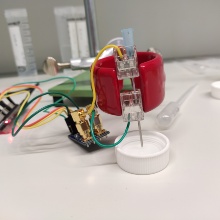Vital parameters, forces and moments, but also temperature and impedance, are variables that often need to be measured on and sometimes even inside the human body in medical technology. We investigate principles and procedures, as well as signal conditioning and evaluation, in order to provide sensors that are as small and lightweight as possible, but also inexpensive and, above all, powerful..
Objective
We would like to measure the most important parameters on and in humans accurately, quickly and cheaply with systems that are as small and light as possible and to forward these data to evaluation and analysis systems.
Core Research Questions
Biocompatibility
Application of technical systems and sensors in the organism requires compliance with numerous requirements and standards on biocompatibility and excludes many tried and tested materials. So what does a good sensor look like?
Size
Humans are the measure of all things and this usually leads to stringent requirements for the size of a sensor. We find solutions that are not only small, but also accurate and easy to manufacture.
Intelligence
How can sufficiently accurate statements about the size of a vital parameter still be made from noisy or insufficient signals? To this end, we are using machine learning methods to explore ways of providing medical staff with the best possible data for making decisions about diagnosis and therapy.


